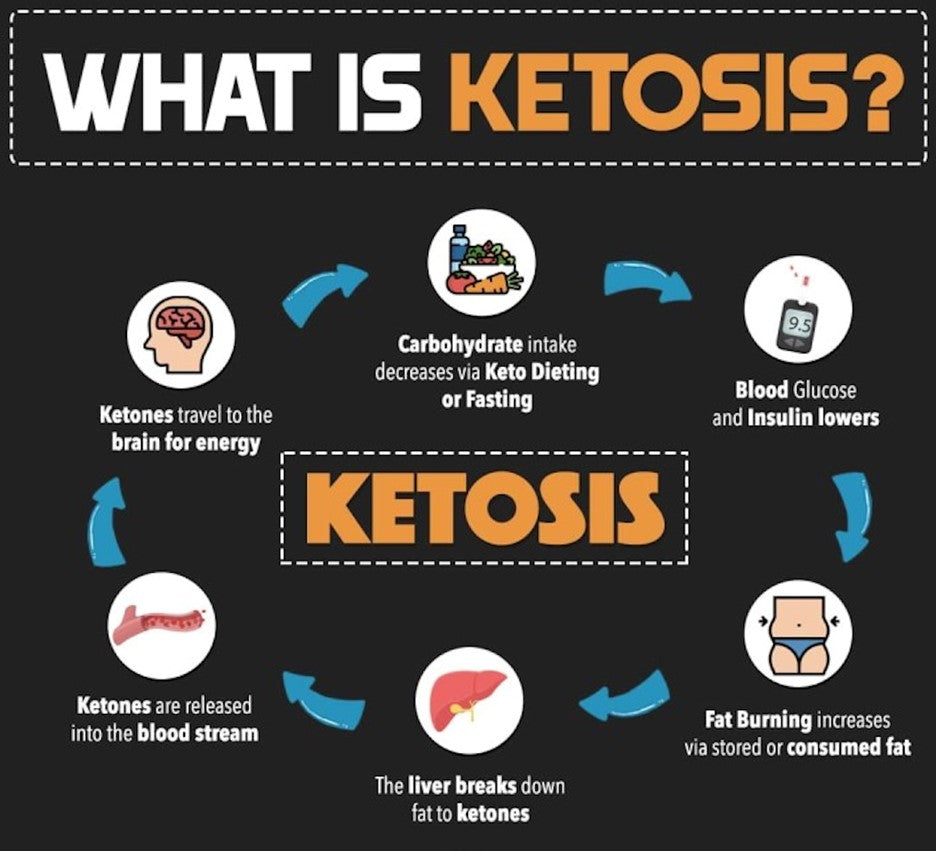Your Cart is Empty

Starting a ketogenic diet is an intimidating yet thrilling journey.
Even if you are not looking to lose weight, the health advantages are compelling enough for you to stick to a ketogenic diet.
However, starting ketosis and staying in it are two different things. It can be a little tricky, particularly for those new to the diet.
Worry not, though.
We’ll help you how to stay in ketosis and get the most out of this new, exciting diet.
But first, let us give you a brief refresher on ketosis.
Ketosis sets in when your body has very limited access to carbohydrates—it’s ideal fuel source.
So, in the absence of carbohydrates, your body starts metabolizing and burning fat reserves (in the form of ketone bodies) to get energy.
Now, your boy’s primary fuel source is fat, including the fat stored in your body and deep inside your organs (which is also particularly difficult to get rid of).
Ketosis can have several health advantages for your body, including:
You can attain the health benefits described above by entering ketosis, but how can you ensure that you stay there?
Well, we can help you out.
Getting off track is one of the biggest challenges to staying in ketosis.
You're much more likely to lose self-control if you don't have access to keto-friendly foods when you need them.

Get your hands on keto-friendly foods like keto custards, keto tortilla chips, or even keto popcorn to keep you company while you watch your favorite movie.
This simple trick will make sure that your body keeps making ketone bodies and utilizing stored and dietary fat as your main fuel source.
Don't cut back on the fat.
Most of us fear fat because we have been conditioned for years that it is unhealthy.
But remember that we're switching from sugar/carbohydrates to fat as our main fuel source.
So, we really can’t run away from it because if you don't have enough fat in your diet, you’ll end up with intense cravings and hunger.

Try looking for keto-friendly fat-filled foods, including butter, cheese, or even some good store-bought collagen creamers.
These creamers have butter, coconut, or MCT fats and you can conveniently add them to your coffee or other foods.
Isn't it one of the most hassle-free ways to add fat to your diet?
In addition to watching out what you eat to maintain your ketosis, you must plan out an exercise schedule.
This is essential since you need your body to stay active in order to burn whatever carbohydrates you eat.
If you consume more than 10 grams of carbohydrates, try engaging in some easy exercises, such as brisk walking or running.
Make sure you get at least 30 minutes of exercise 2-3 times per week. For instance, you can schedule a workout on alternate days of the week.
However, if you can, try to exercise every day. Even if it's just a little bit. You'll stay in ketosis far longer if you run or powerwalk for 30 minutes each day (and you will feel great!)
Ketone test strips are a great tool to tell you if you're about to be booted out of ketosis—even if you are following all the dos and don’ts of it.
These test strips basically work by checking for ketone bodies in your blood, breath, or urine.
At some time, you might find yourself knocked out of ketosis, but it’s not because you underestimated your daily consumption of carbohydrates (which, we agree, is difficult for beginners)
But it’s actually because your body has just become accustomed to the new normal under the keto diet.
Testing can alert you when you're approaching the ketosis threshold and provide information about how the things you eat affect your levels.
All in all, ketone test strips allow you to modify your meal plans accordingly and keep your ketosis under control.

Staying in ketosis doesn’t happen overnight—it takes a lot of patience and commitment.
The ideal approach is to limit your carb intake, ensure that you consume enough fat, and get regular exercise.
Not to mention, get your hands on keto-friendly stuff.
If you are looking for a one-stop shop for all your keto needs, check out Ketoa right away!
Now that you have some solid tips on maintaining your ketosis, why don't we answer some common questions asked by those on a ketogenic diet?
If you believe that your diet has knocked you out of ketosis, your body may react differently to carbohydrates once it has been fat-adapted for a while compared to when you first started the keto diet.
There are a few signs that you're not in ketosis anymore:
Generally speaking, fruit is not a staple of the keto diet.
Fruit typically contains too many carbohydrates due to its high natural sugar content.
But if you are a fruit-lover, don't be disheartened.
You can still enjoy low-carb fruits, like berries, in moderation. These include raspberries, strawberries, blackberries, or blueberries.
If you're trying to maintain ketosis, it's only logical that you're worried about your calorie intake.
However, the good news is that you don't need to worry about calories with a ketogenic diet.
This is because all the fats and proteins you consume will keep your hunger in check for a long time.
But, if you exercise, try being a little more cautious.
Exercise causes you to burn more calories than you take in, so you need to eat more to compensate for the lost calories.
The simple answer is: yes.
Intermittent fasting can actually make keto more successful by increasing your fat-burning and weight loss rate.
Including a little bit of intermittent fasting in your regular eating routine can also help you stay in ketosis for a longer period.
Sign up to get the latest deals, exclusive offers, Keto education & more!